Memories can be triggered by so many different things, a photograph, a smell or even objects. Take for instance the old iron pot that hangs in my mothers yard as a planter. It has a purpose and looks nice, a sort of retirement from a long life of hard work.
I remember from a very young age the old pot sitting in its place across the small stream from my grandparents house, surrounded by stones in a fire pit. I’m not positive, but I believe it used to be on a swinging arm in the fireplace of my grandmother’s childhood home.
In early spring, as temperatures warmed, my grandmother took the heavy winter quilts from the beds and prepared them for summer storage. I can’t recall the reason, but not only were they washed but also boiled in the big iron pot. After a nice long boil they were hung on a cloths line to dry, then carefully folded and put away until winter made its next appearance.
 The pot would then have a short rest, but as spring became summer, canning time would begin. First up were blackberries, picked fresh from the thorny brambles in June. Later on, we would have green beans, corn, tomatoes, beets and many other goodies from the garden. In late summer it would be time for the many different varieties of apples that grew in various places on the farm.
The pot would then have a short rest, but as spring became summer, canning time would begin. First up were blackberries, picked fresh from the thorny brambles in June. Later on, we would have green beans, corn, tomatoes, beets and many other goodies from the garden. In late summer it would be time for the many different varieties of apples that grew in various places on the farm.
Canning was about the same, no matter what was to be put up. First, the fruit or vegetable was packed tightly into quart jars. The jars would be placed in a wire rack and carried over the foot bridge to the pot. For canning, a large round piece of wood with holes bored in a pattern was in the bottom to afford a flat place for the rack to rest. The rack was lowered into the hot water careful not to come over the top of the jars. After proper cooking the rack was removed and the flats and rings were placed on the jars while hot and the lids would seal as they cooled. The process was repeated over and over again until the harvest was complete. We always had plenty of canned goods to feed seven of us through the winter. Having the big pot outdoors  freed up the kitchen to cook daily meals and kept the house a little cooler.
freed up the kitchen to cook daily meals and kept the house a little cooler.
Now, as fall arrives and cooler weather prevailed, it was time to slaughter the hogs. Small pigs were purchased in early spring and placed in the pig pen to be raised over the summer. The pig pen was behind our house with a corner of it on a stream for water. We slopped the pigs every day. Slop usually consisted of chopped corn and table scraps. On this diet, a twenty or thirty pound pig could easily grow to 250-300 pounds over the summer. That’s a lot of bacon!!!
The fresh meat was wonderful! Remembering those fresh pork chops, tender loin, and a big pork roast makes my mouth water. The hams would be hung to cure along with big slabs of pork bellies for bacon. The scrap cuts would be made into sausage which would be canned much the same as fruits and vegetables.
Now let me tell you…hardly anything on Mr. Hog went to waste. The large deposits of fat were boiled and rendered into lard. A lot of the lard was saved for cooking but a portion was used to make soap. Now I don’t claim to know the recipe, but lard, clean ashes and Red Devil lye were the main ingredients. The mixture was placed in the pot and boiled until thick. Then it was ladled from the pot and placed in a flat pan to cool.
When it became hard it was cut into “cakes” or bars as we would say now. Lye soap is mighty harsh but it sure got everything clean. I can remember my grandmother shaving off slices into the laundry in the old wringer washing machine she used. My mom used it also. I can still remember the sharp odor as it dissolved in the water.
The next time you see an old iron pot I hope you will remember my story or even better, some of your own private memories!


